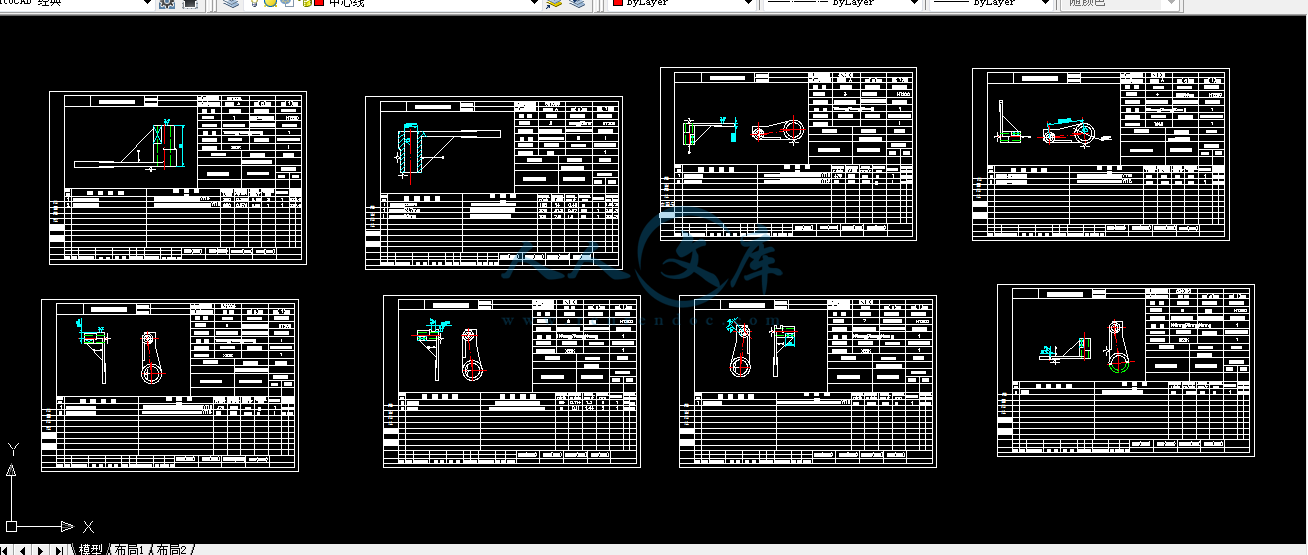拨叉[831006]工艺及镗φ55孔夹具设计
收藏
资源目录

压缩包内文档预览:
编号:485061
类型:共享资源
大小:2.37MB
格式:RAR
上传时间:2015-11-04
上传人:石***
IP属地:广东
20
积分
- 关 键 词:
-
工艺
55
夹具
设计
- 资源描述:
-





- 内容简介:
-
Computer-Aided Process Planning According to the Tool & Manufacturing Engineers Handbook, process planning is the systematic determination of the methods by which a product is to be manufactured economically and competitively. It essentially involves selection, calculation, and documentation. Processes, machines, tools, operations, and sequences must be selected. Such factors as feeds, speeds, tolerances, dimensions, and costs must be calculated. Finally, documents in the form of illustrated process sheets, operation sheets, and process routes must be prepared. Process planning is an intermediate stage between designing and manufacturing the product. But how well does it bridge design and manufacturing? Most manufacturing engineers would agree that, if ten different planners were asked to develop a process plan for the same part, they would probably come up with ten different plans. Obviously, all these plans cannot reflect the most efficient manufacturing methods, and, in fact, there is no guarantee that any one of them will constitute the optimum method for manufacturing the part. What may be even more disturbing is that a process plan developed for a part during a current manufacturing program may be quite different from the plan developed for the same or similar part during a previous manufacturing program and it may never be used again for the same or similar part. That represents a lot of wasted effort and produces a great many inconsistencies in routing, tooling, labor requirements, costing, and possibly even purchase requirements. Of course, process plans should not necessarily remain static. As lot sizes change and new technology, equipment, and processes become available, the most effective way to manufacture a particular part also changes, and those changes should be reflected in current process plans released to the shop. A planner must manage and retrieve a great deal of data and many documents,including established standards, mach inability data, machine specifications, tooling inventories, stock availability, and existing process plans This is primarily an information handling job, and the computer is an ideal companion There is another advantage to using computers to help with process planning Because the task involves many interrelated activities, determining the optimum plan requires many iterations. Since computers can readily perform vast numbers of comparisons, many more alternative plans can be explored than would be possible manually ntsA third advantage in the use of computer-aided process planning is uniformity. Several specific benefits Can be expected from the adoption of computer-aided process planning techniques: 1 Reduced clerical effort in preparation of instructions 2 Fewer calculation errors due to human error 3. Fewer oversights in logic or instructions because of the prompting capability available with interactive computer programs 4 Immediate access to up to date information from a central database 5 Consistent information, because every planner accesses the same database 6. Faster response to changes requested by engineers of other operating departments 7 Automatic Use of the latest revision of a part drawing 8. More detailed, more uniform process-plan statements produced by word processing techniques. 9 More effective use of inventories of tools, gages, and fixtures and a concomitant reduction in the variety of those items. 10. Better communication with shop personnel because plans can be more specifically tailored to a particular task and presented in unambiguous,proven language. 11. Better information for production planning, including cutter-life, forecasting, materials-requirements planning, scheduling, and inventory control. Most important for CIM, computer-aided process planning produces machine-readable data instead of handwritten plans. Such data can readily be transferred to other systems within the C1M hierarchy for use in planning. There are basically two approaches to computer-aided process planning: variant and generative. In the variant approach, a set of standard process plans is established for all the parts families that have been identified through group technology. The standard plans are stored in computer memory and retrieved for new parts according to their family identification. Again, GT helps to place the new part in an appropriate family. The standard plan is then edited to suit the specific requirements of a particular job. In the generative approach, an attempt is made to synthesize each individual plan using appropriate algorithms that define the various technological decisions that must ntsbe made in the course of manufacturing. In a truly generative process-planning system, the sequence of operations, as well as all the manufacturing-process parameters, would be automatically established without reference to prior plans. In its ultimate realization, such an approach would be universally applicable: present any plan to the system, and the computer produces the optimum process plan. No such system exists, however. So called generative process-planning systems-and probably for the foreseeable future-are still specialized systems developed for a specific operation or a particular type of manufacturing process. The logic is based on a combination of past practice and basic technology. nts计算机辅助工艺过程设计 根据工具与制造 工程师手册,工艺过程是能够经济地和有竞争力地将产品制造出来的一整套方法。它主要由选择、计算和建立工艺文件组成。对加工方法、机床、刀具、工序和顺序必须进行选择。对于一些参数如进给量、速度、公差、尺寸和成本等应该进行计算。最后,应该制订带工序简图的工艺过程卡片,工序卡片和工艺路线等方面的工艺文件。工艺过程是产品设计和制造的中间环节。那么,它是如何将设计与制造联接起来的呢 ? 大部分制造工程师都会同意这个看法,即如果 10 个不同的工艺人员编制同一个零件的工艺规程,他们很可能得出 10 种不同的方案。显然,并不是所有这些 方案都能反映最适当的制造方法,而且,事实上也不能保证它们中的任何一个方案是由加工这个零件的最好的方法组成的。 在目前的制造过程中的一个更为混乱的事情是,对于一个零件来说,现在所 编制的工艺规程可能与以前在制造过程中所编制的同一个零件或者相似零件的工艺规程相差很多,而且这个工艺规程可能再也不会应用于同一个零件或者相似 零件。这说明很多工作成果都被浪费了,而且在工艺路线、工艺装备、对工人的要求和成本等方面都不一致,甚至对外购件的要求都不一样。 当然工艺规程不应该是一成不变的。随着产品批量的变化和新技术、 新设 备、新的加工方法的出现,加工制造某一特定零件最适当的方法也会发生变化,而且这些变化应该在车间目前使用的加工工艺规程中反映出来。 工艺人员应该管理和检索大量的数据和很多文件,其中包括:已经建立了的 标准、可加工性数据、机器的规格、工艺装备的清单、原材料库存量和一些目前正在应用的工艺文件。这主要是一些信息处理工作,而计算机是完成这项工作的一个理想助手。 在设计工艺过程时应用计算机还有一个优点。因为这项工作涉及到许多相 互关联的事情,在确定最优的方案时,需要进行许多次迭代。由于计算机可以很 容易地进行大量的比较工作,它比人工所能够分析的可供选择的方案要多得多。 采用计算机辅助工艺过程设计的第三个优点是所设计的工艺过程具有一致性。 采用计算机辅助工艺过程设计可以获得以下几点好处: 1.在准备工艺文件时,减少了书写工作量。 2. 减少了在进行人工计算时所产生的错误。 3. 由于交互式计算机程序的提示功能而减少了在逻辑和说明方面的疏漏 4. 通过中央数据库可以直接利用最新的信息 . 5. 由于每一个工艺人员都利用相同的数据库,因此,可以保证信息的一致nts性。 6. 对由其他业务部门的工程技 术人员所提出的修改意见作出快速反应。
- 温馨提示:
1: 本站所有资源如无特殊说明,都需要本地电脑安装OFFICE2007和PDF阅读器。图纸软件为CAD,CAXA,PROE,UG,SolidWorks等.压缩文件请下载最新的WinRAR软件解压。
2: 本站的文档不包含任何第三方提供的附件图纸等,如果需要附件,请联系上传者。文件的所有权益归上传用户所有。
3.本站RAR压缩包中若带图纸,网页内容里面会有图纸预览,若没有图纸预览就没有图纸。
4. 未经权益所有人同意不得将文件中的内容挪作商业或盈利用途。
5. 人人文库网仅提供信息存储空间,仅对用户上传内容的表现方式做保护处理,对用户上传分享的文档内容本身不做任何修改或编辑,并不能对任何下载内容负责。
6. 下载文件中如有侵权或不适当内容,请与我们联系,我们立即纠正。
7. 本站不保证下载资源的准确性、安全性和完整性, 同时也不承担用户因使用这些下载资源对自己和他人造成任何形式的伤害或损失。

人人文库网所有资源均是用户自行上传分享,仅供网友学习交流,未经上传用户书面授权,请勿作他用。
 川公网安备: 51019002004831号
川公网安备: 51019002004831号